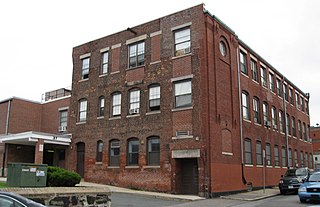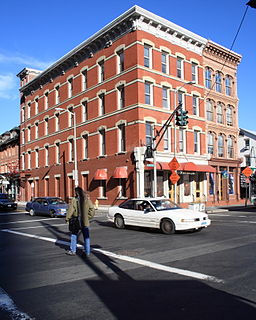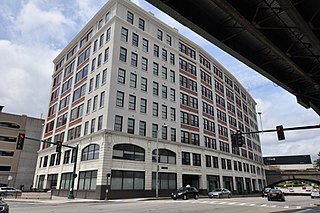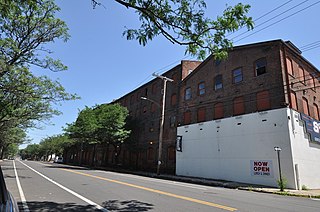
The Wilcox, Crittenden Mill, also known as Wilcox, Crittenden Mill Historic District, is a 17-acre (6.9 ha) property in Middletown, Connecticut that was listed on the National Register of Historic Places in 1986. It was the location of the Wilcox, Crittenden company, a marine hardware firm. The historic district listing included four contributing buildings and three other contributing sites.
Newhallville is a neighborhood in the city of New Haven, Connecticut, named for industrialist George Newhall.

The Berger Factory is a historic factory building at 37 Williams Street in Boston, Massachusetts. Built in 1902, it was home to one of the nation's first manufacturers of precision engineering and surveying instruments, and a surviving example of Roxbury's late 19th-century industrial development. It was listed on the National Register of Historic Places in 1980, and now houses residences.

The Winchester Repeating Arms Company Historic District is a historic district in New Haven, Connecticut that was listed on the National Register of Historic Places in 1988. It includes 867 properties, which "include 858 major structures and 131 notable outbuildings." Of these structures, 876 are buildings deemed to contribute to the historical and/or architectural significance of the area, and most of these are residential. However the center of the district is "dominated" by the 75-acre (30 ha) tract of the former Winchester Repeating Arms Company, which contains industrial buildings.

The Baystate Corset Block is a historic commercial block at 395-405 Dwight St. and 99 Taylor Street in Springfield, Massachusetts. Built in 1874 and twice enlarged, it was from 1888 to 1920 home of the Baystate Corset Company, one of the nation's largest manufacturers of corsets. The building was listed on the National Register of Historic Places in 1983.

The Dwight Street Historic District is an irregularly shaped 135-acre (55 ha) historic district in New Haven, Connecticut. The district is located immediately west of the center of Downtown New Haven and is generally bounded by Elm Street on the north, Park Street on the east, North Frontage Road on the south, and Sherman Avenue on the west. It contains one of the city's highest concentrations of well-preserved 19th and early 20th-century residential architecture, much of which was developed for the working classes in the city's factories. It was listed on the National Register of Historic Places in 1983. The historic district includes most of the Dwight neighborhood and several blocks of the northeast corner of the West River neighborhood.

The Dry Dock Complex consists of six interconnected buildings located at 1801–1803 Atwater Street in Detroit, Michigan, as well as the remains of a nearby dry dock at 1900 Atwater Street. The 1801-1803 Atwater complex is also known as the Globe Trading Company Building, and in 2015 was opened by the Michigan Department of Natural Resources as the Outdoor Adventure Center.

The Elisha Blackman Building, also known as the York-Chapel Building, is a historic mixed commercial-residential building at 176 York Street in the Downtown New Haven neighborhood of New Haven, Connecticut. Built in 1883, it is a finely crafted example of 19th-century commercial architecture, and is one of the few such buildings to survive in the city. It was listed on the National Register of Historic Places in 1978.

The Imperial Granum-Joseph Parker Buildings, also known historically as the Del Monico Building, are a pair of conjoined historic commercial buildings at Elm and Orange Streets in downtown New Haven, Connecticut. Built in 1875 and 1877, the two buildings are among the finest examples of the architecture of that period in the city, with one sporting one of the city's only surviving cast iron facades. The buildings were listed on the National Register of Historic Places in 1986.

The Strouse, Adler Company Corset Factory is a historic factory complex at 78-84 Olive Street in New Haven, Connecticut. Developed between 1876 and 1923, it was the largest and oldest of the city's several corset manufacturers, and remained in continuous operation for that purpose until 1998. The complex was listed on the National Register of Historic Places in 2002. It has since been converted into residential use.

The Kraus Corset Factory is a historic industrial property at 33 Roosevelt Drive in Derby, Connecticut. The oldest portion of the large brick, built 1879, faces Third Street, while a c. 1910 addition extends along Roosevelt Drive. It is the only major building to survive from Derby's period of corset manufacturing. It was built by Sidney Downs, one of Derby's leading businessmen of the period. The building was listed on the National Register of Historic Places on February 12, 1987. It has been converted into apartments.

The A. Mendelson and Son Company Building is located on Broadway in Albany, New York, United States. It is a brick industrial building erected in the early 20th century. In 2003 it was listed on the National Register of Historic Places. It is one of the few intact examples of the early 20th century industrial architecture of Albany.

The J.J. Deal and Son Carriage Factory was the largest factory built in Jonesville, Michigan. It is the only 19th century factory remaining in the City. It is located at 117 West Street. On August 1, 2012, the building was added to the National Register of Historic Places. The building was redeveloped into the Heritage Lane Apartments in 2015.

The H. D. Smith Company Building is a historic industrial building at 24 West Street in Plantsville, Connecticut. With a construction history dating to 1882, it is one of the more architecturally interesting examples of Southington's industrial architecture, and was home to H. D. Smith & Co. from construction to the 1920s. It was listed on the National Register of Historic Places in 1977.

The Mansuy and Smith Automobile Showroom Building is a historic commercial building at 38-42 Elm Street in Hartford, Connecticut. Built about 1900, it is an early example of an automobile showroom, used by a local carriage manufacturer seeking to transition to the new technology. It was listed on the National Register of Historic Places in 2016.

The Osgood Bradley Building is an historic industrial building at 18 Grafton Street in Worcester, Massachusetts. Completed in 1916, the eight-story brick building is notable for its association with the Osgood Bradley Car Company, an early manufacturer of both railroad cars and automobiles. The building was listed on the National Register of Historic Places in 2018.

The New Haven Clock Company Factory is a historic industrial complex at 133 Hamilton Street in New Haven, Connecticut. Developed between 1866 and 1937, it consists of ten interconnected brick buildings that are the surviving elements of a major clock-making business that operated here until 1956. The property was listed on the National Register of Historic Places in 2017.

The Matthews and Willard Factory was a historic industrial site at Cherry Avenue and North Elm Street in Waterbury, Connecticut. Founded in 1874, Matthews and Willard contributed to the expansion of Waterbury's brass processing industry. The plant remained little altered from its last period of expansion c. 1900, and was a good example of period industrial architecture. It was listed on the National Register of Historic Places in 1988, and was demolished in 2012. As of 2018, the site stands vacant.

The Meriden Curtain Fixture Company Factory is a historic factory complex at 122 Charles Street in Meriden, Connecticut. Built in 1892 for a company founded in 1869, it is a good example of late-19th century industrial architecture, and is notable for its association with Charles Parker, one of the city's leading industrialists of the period. It was listed on the National Register of Historic Places in 1986. The complex has been converted to residential use.

The Pines Bridge Historic District encompasses a historic industrial and commercial village in North Haven, Connecticut. Located just west of the town green and centered around the Broadway bridge over the Quinnipiac River, the village developed first as a commercial hub around a 17th-century bridge at the site, and then as a small industrial village in the 19th century. Now mainly residential, it was listed on the National Register of Historic Places in 1988.





















